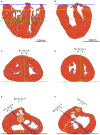Polarized Light Imaging of the Myoarchitecture in Tetralogy of Fallot in the Perinatal Period
- PMID: 33072668
- PMCID: PMC7536283
- DOI: 10.3389/fped.2020.503054
Polarized Light Imaging of the Myoarchitecture in Tetralogy of Fallot in the Perinatal Period
Abstract
Background: The pathognomonic feature of tetralogy of Fallot (ToF) is the antero-cephalad deviation of the outlet septum in combination with an abnormal arrangement of the septoparietal trabeculations. Aims: The aim of this article was to study perinatal hearts using Polarized Light Imaging (PLI) in order to investigate the deep alignment of cardiomyocytes that bond the different components of the ventricular outflow tracts both together and to the rest of the ventricular mass, thus furthering the classic description of ToF. Methods and Materials: 10 perinatal hearts with ToF and 10 perinatal hearts with no detectable cardiac anomalies (control) were studied using PLI. The orientation of the myocardial cells was extracted and studied at high resolution. Virtual dissections in multiple section planes were used to explore each ventricular structure. Results and Conclusions: Contrary to the specimens of the control group, for all ToF specimens studied, the deep latitudinal alignment of the cardiomyocytes bonds together the left part of the Outlet septum (OS) S to the anterior wall of the left ventricle. In addition, the right end of the muscular OS bonds directly on the right ventricular wall (RVW) superior to the attachment of the ventriculo infundibular fold (VIF). Thus, the OS is a bridge between the lateral RVW and the anterior left ventricular wall. The VIF, RVW, and OS define an "inverted U" that roofs the cone between the interventricular communication and the overriding aorta. The opening angle and the length of the branches of this "inverted U" depend however on three components: the size of the OS, the size of the VIF, and the distance between the points of insertion of the OS and VIF into the RVW. The variation of these three components accounts for a significant part of the diversity observed in the anatomical presentations of ToF in the perinatal period.
Keywords: 3D architecture myocardial cells; outlet septum; polarized light imaging; tetralogy fallot; ventriculo infundibular fold.
Copyright © 2020 Truong, Jouk, Auriau, Michalowicz and Usson.
Figures




References
LinkOut - more resources
Full Text Sources
Miscellaneous

